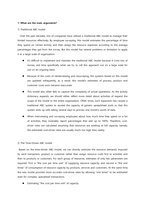Essay Assignment_Alto_MBA_Time drive activity based costing_Prof Teemu Malmi
1) Traditional ABC model
Over the past decades, lots of companies have utilized a traditional ABC model to manage their limited resources effectively. By employee surveying, this model estimates the percentage of time they spend on certain activity and then assign the resource expenses according to the average percentages they get from the survey. But this model has several problems or limitation to apply it to a large scale of organization.
It’s difficult to implement and maintain the traditional ABC model because it costs lots of money and time specifically when we try to roll this approach out on a large scale for use on an ongoing basis.
Because of the costs of reinterviewing and resurveying, the systems based on this model are updated infrequently, as a result, this model’s estimates of process, product and customer costs soon became inaccurate.
This model also often fails to capture the complexity of actual operations. As the activity dictionary expands, we should either reflect more detail about activities of expand the scope of the model to the entire organization. Often times, such expansion has caused a traditional ABC system to exceed the capacity of generic spreadsheet tools so that this system ends up with taking several days to process one month’s worth of data.
When interviewing and surveying employees about how much time they spend on a list of activities, they invariably report percentages that add up to 100%. Therefore, cost-driver rates are calculated assuming that resources are working at full capacity, namely, the estimated cost-driver rates are usually much too high than reality.
2) The Time-Driven ABC model
Based on the time-driven ABC model, we can directly estimate the resource demands imposed by each transaction, product or customer rather than assign resource costs first to activities and then to products or customers. For each group of resources, estimates of only two parameters are required. First is “the cost per time unit” of supplying resource capacity, and second is “the unit times” of consumption of resource capacity by products, services and customers. At the same time, the new model provides more accurate cost-driver rates by allowing “unit times” to be estimated even for complex, specialized transactions.
Estimating “the cost per time unit” of capacity
Instead of surveying the employees on how they spend their time, companies could directly estimate the practical capacity of the resources supplied as percentage of the theoretical capacity, assuming that piratical full capacity is 80% to 85%. And for more systematic approach, we can review past activity levels and identify the month with the largest number of orders handled without excessive delays, poor quality, overtime, or stressed employees.
Estimating “the unit times” of activities
Next, companies determine the time it takes to carry out one unit of each kind of activity. These numbers can be obtained through interviews or by direct observation. The important point is that we don’t ask about the percentage of time an employee spends doing an activity but ask about how long it take to complete one unit of that activity.
Deriving cost-driver rates
The cost-driver rates can be calculated by multiplying the cost per time unit and the unit times. The calculation of resource cost per time unit forces the company to incorporate estimates of the practical capacities of its resources, allowing the ABC cost drivers to provide more accurate signals about the cost and the underlying efficiency of its processes.
Analyzing and reporting costs
Time-driven ABC enables companies to report their cost on an ongoing basis in a way that reveals both the costs of a business’s activities as well as the time spent on them. The report highlights the difference between capacity supplied and the capacity used. Companies can review the cost of the unused capacity and contemplate actions to determine whether and how to reduce the costs of supplying unused resources in subsequent periods. In some cases, the information can save companies that are considering expansion from making unnecessary new investments in capacity because they find that they’re underutilizing their capacity.
Updating the model








 분야
분야


